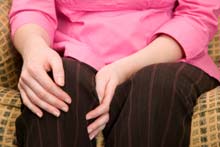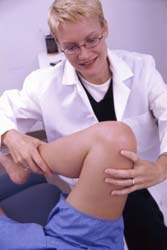Fast, Healthy Relief From Joint Pain … Recover from Aches and Pains Naturally (Even Pain That’s Severe, Reoccurring and Chronic)
by www.SixWise.com
Joint pain, which can occur at any point in your body where two or more bones meet, is one of the most common health complaints among Americans. It can range from mild soreness when you try to move your joint to debilitating pain that makes it virtually impossible to use the joint.
In these latter cases, joint pain can make even everyday tasks painful.
|

At least 30 percent of adults experience joint pain, and the knee is the most common site of pain.
|
What Causes Joint Pain?
Many people associate joint pain with old age, but while reports of severe joint pain increase with age, according to the National Center for Health Statistics, aging itself does not cause joint pain.
In fact, joint pain can occur at just about any age. About 10 percent of U.S. women, and 7 percent of U.S. men, say they have severely painful joints, with the knee being the joint that causes the most pain, according to Health United States, 2006, released by the Centers for Disease Control and Prevention's (CDC) National Center for Health Statistics.
Further, about 30 percent of adults said they had experienced some type of joint pain during the preceding 30 days. The leading areas affected by joint pain were:
Some common causes of achy joints include rheumatoid arthritis, osteoarthritis, overuse of the joint, injury to the joint and bursitis.
You may also end up with joint pain from a sports injury or improper sports technique, such as a bad swing in tennis or golf. Poor posture when working at a computer can also lead to chronic pain in your joints.
Fortunately, whether your pain is in your back, knees, hands or elbow, and whether you know the cause or not, there are natural methods that can help steer you toward a more pain-free life.
Why Prescription Painkillers are Not the Best Solution …
When pain strikes, about 80 percent of Americans reach for over-the-counter drugs or home remedies to help. Sixty percent have also tried other pain-relief methods including prescription drugs, bed rest and prayer, according to a phone survey by Stanford University Medical Center, ABC News and USA Today.
More than 10 percent of adults now rely on prescription painkillers everyday (interestingly, the survey reported that prayer and prescription drugs worked best, and equally well, in addressing Americans' pain).
Before we delve into the natural pain relief options, you may be wondering why you, too, shouldn’t get a prescription for pain medications from your doctor. For starters, these medications do nothing to address the underlying cause of the joint pain, and often in order to be effective the dosages can cause debilitating drowsiness, nausea, dizziness, and other effects.
Non-steroidal anti-inflammatory drugs or NSAIDs, which are often prescribed for pain relief, have also been linked to serious side effects including bleeding ulcers, heart problems, and kidney and liver failure.
|

Physical therapy and chiropractic care can help to permanently resolve joint pain.
|
Chiropractic Care and Massage
Other non-drug pain relief options include massage and chiropractic care.
According to the American Chiropractic Association:
Chiropractic is a branch of the healing arts which is concerned with human health and disease processes. Doctors of Chiropractic are physicians who consider man as an integrated being and give special attention to the physiological and biochemical aspects including structural, spinal, musculoskeletal, neurological, vascular, nutritional, emotional and environmental relationships.
Every Doctor of Chiropractic is different, and will use varying chiropractic methods to relieve your pain, including ART. According to the first survey above, chiropractic (and massage therapy) ranked second-best at relieving pain.
Regular Exercise is Also Important
It's important to rest painful joints when they feel fatigued, however exercise is actually beneficial for joint pain. A lack of exercise can actually cause your joints to become even more painful and stiff.
According to the Mayo Clinic, exercise can:
-
Strengthen the muscles and tissues around your joints
-
Help you maintain bone strength
-
Give you more strength and energy
-
Help you control your weight, which also takes pressure off of your joints
Exercise also works to relieve pain by prompting your body to release chemicals called endorphins that actually block pain signals from reaching your brain.
"Endorphins are the body's natural pain-relieving chemicals that in many cases are more powerful than morphine," says Edward Laskowski, M.D., a physical medicine and rehabilitation specialist and co-director of the Sports Medicine Center at Mayo Clinic, Rochester, Minn.
For tips on which exercise methods are best for those with joint pain, be sure to read The Nine Best Exercises for You if You Have Aching Joints.
You should also take extra care to protect your joints while you exercise by:
-
Putting a hot pack on the joints you'll be working out before you exercise (for about 20 minutes). This will help to relax your joints and relieve pain before you begin.
-
Stretching or gently warming up your joints before your workout.
-
Using gentle, gradual movements, not jerky ones, while you exercise.
-
Taking a break if you notice pain (beyond your normal pain).
-
Applying a cold pack to your joints (for 10-15 minutes) after you exercise to reduce any swelling or pain.
A Healthy Diet is Important for Healthy Joints
Eating a healthy diet is incredibly important to maintain your weight and benefit your overall health, including your joints. Focusing on getting plenty of fruits and vegetables, which are naturally anti-inflammatory, may also help.
For extra insurance, you may also want to take a preventative supplement that will help support healthy bones and joints. Look for a whole food supplement that contains these ingredients:
The following combination of ingredients may be especially helpful for supporting healthy bone-joint complex, especially those subject to repetitive use:
-
Vitamin A
-
Vitamin C
-
Calcium
-
Niacin
See Your Practitioner for Help With Joint Pain
The tips in this article are a starting point, but if you’re suffering from stiff or achy joints, you should make an appointment today for a complete Wellness consultation.
Your health care practitioner can help determine the cause of your pain, and devise a treatment strategy that will resolve your symptoms and address the underlying causes.
Recommended Reading
Does Cracking Your Knuckles Really Cause Arthritis?
Physical Pain: 8 Non-Drug Tactics to Eliminate Back, Joint & Other Pain
Sources
CDC Data & Statistics
Medical News Today May 9, 2005
MayoClinic.com